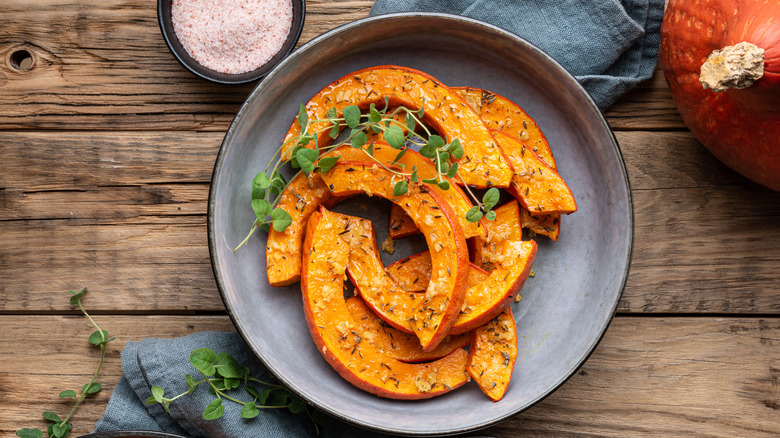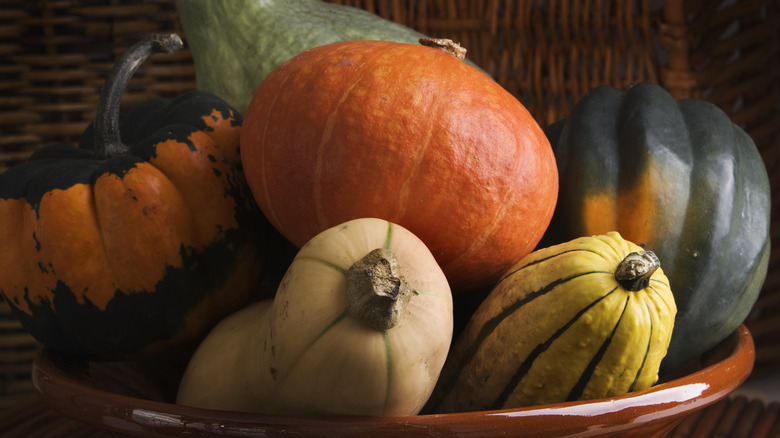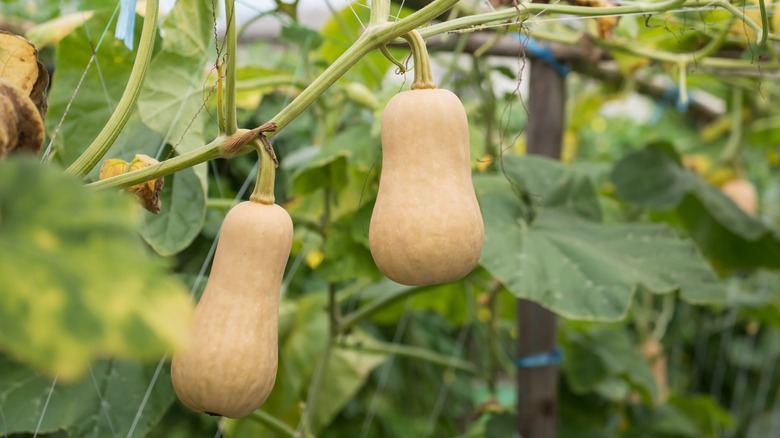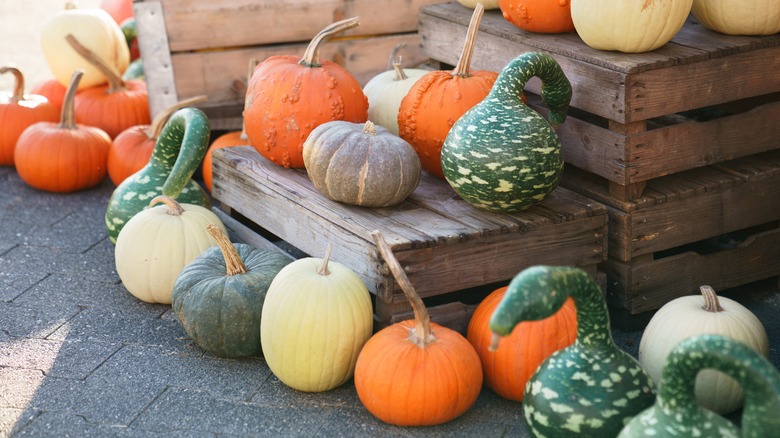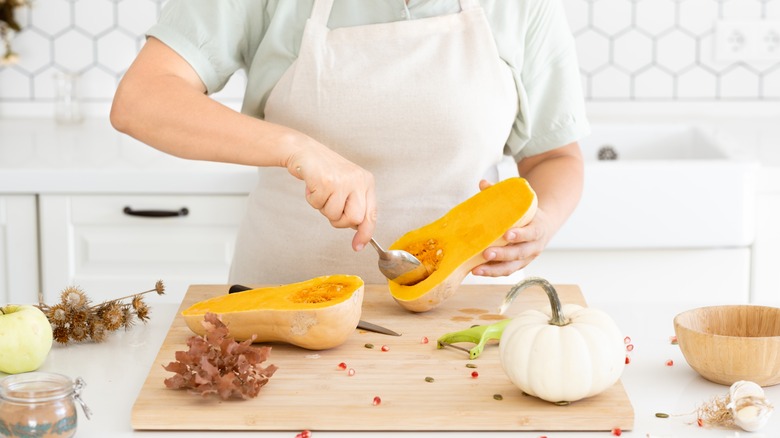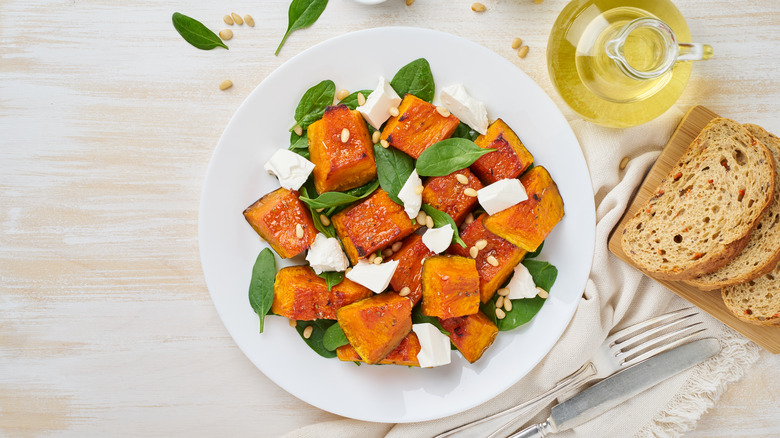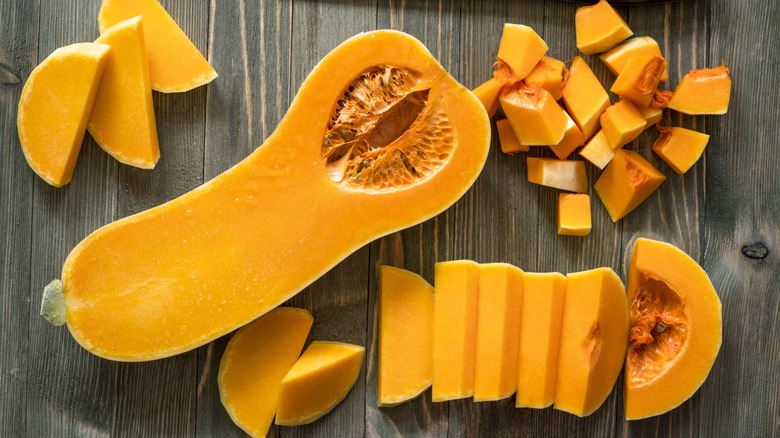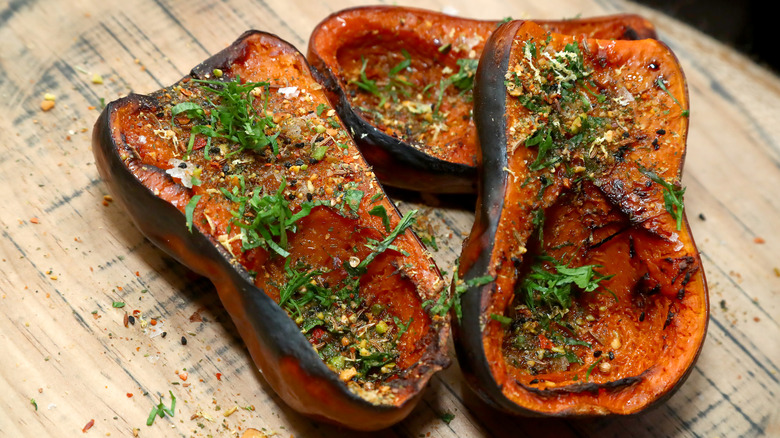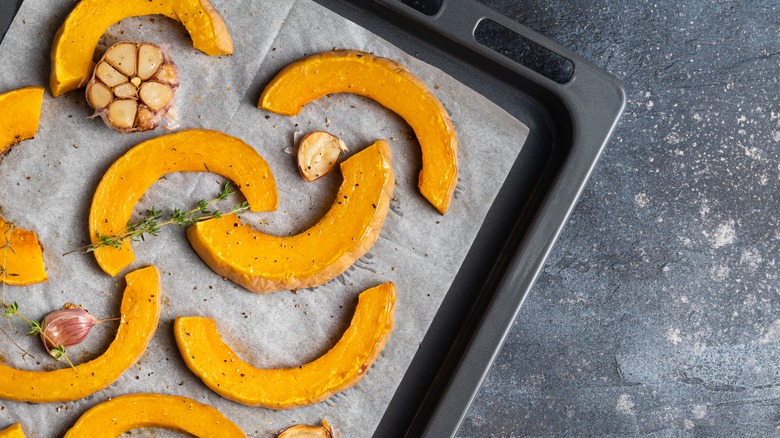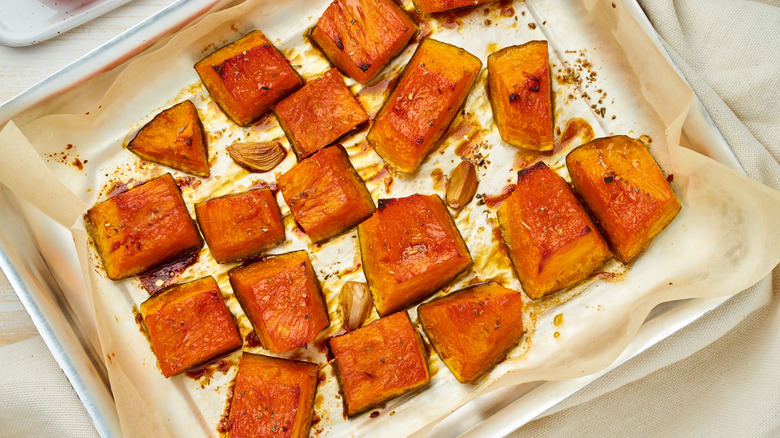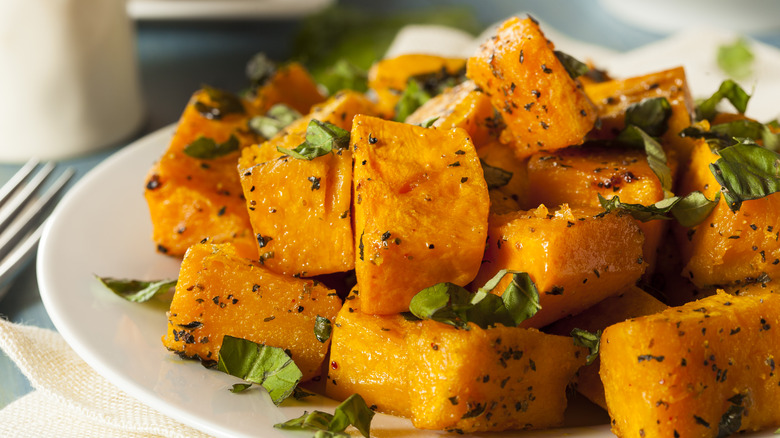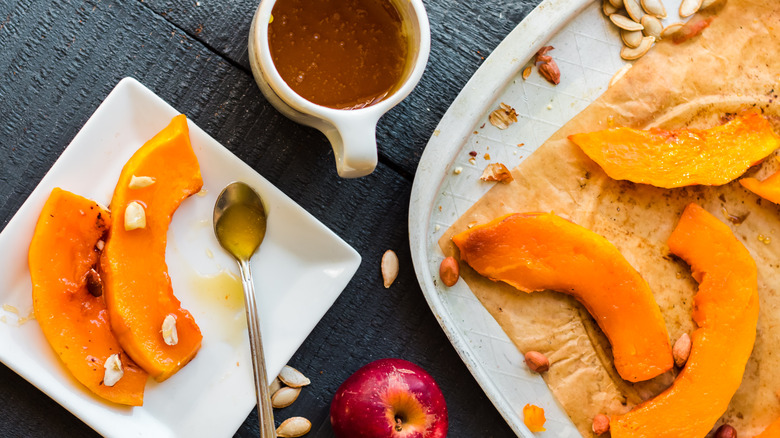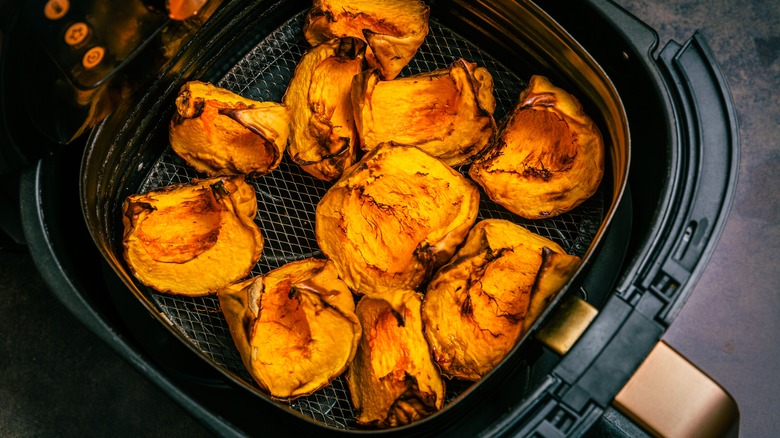How To Perfectly Roast Squash Every Time
We usually categorize squash as a sturdy winter vegetable, but this versatile crop is not exclusive to winter and is technically grouped as fruit. Along with favorite winter versions, it also includes summer varieties, such as zucchinis, which you will easily recognize for its soft skin, tender flesh, and subtle flavors. On the other hand, winter squash usually has tougher skin and flesh but a more potent flavor profile, typically displayed as a medley of sweet, earthy, and nutty nuances.
Squash is a nutritional powerhouse that packs plenty of vitamins and minerals, making it a welcome addition to our diets. Besides the classic option of blending it into soups and creamy mash, there are multiple ways to incorporate more squash into our daily eating routine. It makes a wonderful addition to salads and a hearty ingredient in pies, casseroles, and risotto. You can also use it as a great cooking vessel and stuff it with various delicious combinations.
Though it can be sautéed, fried, steamed, or boiled, squash shows its finest qualities when roasted. Roasting brings out natural sweetness, intensifies the flavors, and creates the ideal soft and crispy ratio. Though it seems like a relatively straightforward task, there are several essential requirements to get consistently good, perfectly roasted squash. Follow these directions, and your squash will always come out of the oven intensely caramelized and bursting with flavor.
Choose the perfect variety
Squash comes in many forms and sizes; as you may guess, it's not the one-size-fits-all approach. Some work better in savory combinations, while others make a perfectly luscious, sweet pie filling. And while some work better cooked, fried, or steamed, others are ideal for roasting.
Luckily, many squash varieties fall into the best for roasting category as most handle heat well and generally improve in texture and flavor. For an ideal roasting squash, look for winter varieties such as butternut, acorn, or delicata. Roasting will help to bring out their inherent sweetness and amp up caramelization. Spaghetti squash is another popular oven-roasted option, as the flesh becomes soft and pliable and can conveniently be turned into spaghetti-like threads. Other alternatives include common varieties such as butterkin and honeynut, but you can't go wrong with any winter squash, as most will come out of the oven perfectly roasted.
On the other hand, summer varieties are not well-built for roasting. This group includes familiar names such as zucchini, chayote, and yellow squash, which usually have thin skin and juicy flesh. Because of this, they are better suited for grilling, frying, and sautéing. They are generally too tender for roasting, turning them into a soft, watery mess that can't hold form.
Make sure the squash is healthy and perfectly ripe
When you choose the ideal roasting variety, the next step is to select the finest representative of the bunch. You'll need to find a perfectly ripe specimen without any blemishes that can mess up the flavor and texture of your roasted squash.
As most winter varieties usually have thick skin, it is sometimes difficult to know when they reach the perfect ripeness, but a few tricks can tell you when it's ready for use. The easiest way is to check the skin. It should not be glossy and needs to be firm to the touch. If you can pierce it by gently pressing your finger against the surface, it's most likely underripe. Color is unreliable as it varies across the range, but you want to look for consistent, uniform color, indicating that each part of the squash is at the same stage of ripeness. The weight should also be a good indicator — heavier is usually better. Finally, try the classic knock trick, and if you hear a deep, hollowed sound, the squash should be ready for consumption. Of course, you want to skip any squash with visible mold, indentations, or scratches.
Unripe squash can be consumed, but it typically lacks flavor, and though roasting will make it softer, it will not affect its taste, resulting in subpar roasted squash.
Store it properly before use
The great thing about squash, especially those sturdy winter varieties, is that they have a relatively long shelf life and retain most good qualities. However, you'll need to store them properly to keep them healthy, flavorful, and ready for roasting.
An absolute prerequisite for appropriate storage is a cool and dry environment. Squash doesn't successfully cope with moisture or humidity. They are incredibly susceptible to rot and can quickly go moldy. Any soft spot will quickly lead to decay. You should also ensure that there is no physical damage on the surface, so if you have more examples in storage, try not to stack them on top of each other or too compactly. Like any fruit, you want to avoid exposing it to direct sunlight as the heat immediately speeds up deterioration. Of course, storing the squash whole and using it all at once is best. Sliced-up or cubed pieces will deteriorate quickly.
If squash is stored correctly, it will preserve sweetness, flavor intensity, and texture, which will all improve during roasting. If you suspect the squash has gone bad, you do not want to roast it or use it in the kitchen.
Make sure to clean and prep your squash before roasting
Squash is notorious for its difficult cleaning and prep process, which is usually time-consuming and potentially hazardous due to its large size and tough skin. However, meticulous cleaning and peeling are necessary to ensure the squash will come out of the oven perfectly roasted.
Regardless of what you plan to do with your squash, always give it a good scrub beforehand, as you do not want dirt or impurities on the roasting pan. Peeling is the usual method if you want to roast cubed pieces, and it can be done with a pairing knife or a vegetable peeler; just make sure to follow the shape and the silhouette. Though squash has an edible peel, in most cases, it's too brittle or chewy, even after roasting, so you want to get it out of your tender roasted pieces. Finally, remove the stringy pulp from the insides as it's fibrous and not pleasant to eat roasted, but you can add it to soups and stews. The seeds are perfectly edible, but you'd want to remove and roast them separately.
Dice it to amp up caramelization
There are multiple ways you can prepare the squash for roasting, but if you want it to come out of the oven with tons of caramelized flavors, you should dice it. This shape has several advantages: it allows faster roasting, more room to play with spices, and a consistent bake you can easily control and monitor for doneness.
Diced squash is the way to go if you are in a hurry, as it will roast faster than any other method. It is also best if you want your pieces to hold form. As each side is exposed to heat, it can attain nice browning and retain a firmer structure, giving your squash a good texture and chew. This is perfect if you want to add the pieces to a salad or serve as a side dish. If you are a fan of more robust flavors, cubed squash also gives you more surface to pack all your favorite spices.
The best thing about this shape is the amount of caramelization. As your squash roasts, it naturally releases sweetness that the heat turns into a gooey, caramel coating. As cubes have more surface exposed to heat, they will deliver more caramelization and improve the flavor of your squash.
Uniform size and shape are essential
Whichever shape you choose when roasting squash, it's essential to ensure that all the pieces are approximately the same size and thickness. This goes back to the fundamental roasting postulate claiming that this is the only way to enable consistency and a successful, even bake. If the pieces are the same size, the shape is the less important factor.
Uniform size enables even distribution of heat. This means that all the pieces will cook at approximately the same time, preventing the dreadful situation in which some pieces brown too fast or turn into unappetizing mush while others have not had time to cook through. This will also keep your dish looking neat and visually attractive.
Of course, following this advice does not mean you'll have to pull out your trusty ruler. Keeping the pieces roughly the same size will be enough for impressive results.
Roast it whole or halved for completely hassle-free experience and smooth texture
Roasting whole squash is not traditional, but the technique works perfectly. You'll just have to clean the squash, poke some holes on top, and leave it inside the oven until the skin tenderizes and dark blisters appear on the surface. The next step is to cut it in half, scoop out all the delicious smooth flesh, and use it however you like. The downside to this method is the lack of caramelization. As no flesh is exposed to heat, the squash won't get any browning or dark caramelly bits that deliver complexity and depth of flavor.
If you are going for a smooth texture with an added caramelization bonus, the ideal way is to cut the squash lengthwise into two equal pieces. It's best to turn the squash flesh faced down, keeping it in contact with the pan. The squash will tenderize pretty quickly, and the pieces that were in direct contact with the heat from the pan will develop rich caramelization. Essentially, you'll get a velvety, smooth puree that blends earthy sweetness and caramelized flavors. This method also allows you to clean the pulp beforehand and skip the finicky cleaning after the squash is already fork-tender.
Use good oil and apply it generously
In most cases, roasting squash calls for a splash of oil. You'll either want to thoroughly coat the cubes or brush the slices and halves before they go into the oven. Oil has several purposes in this combination. It boosts flavor and prevents the pieces from drying out by making a thin, protective coating.
For the best option, use oil with a higher smoke point, such as canola, avocado, sunflower, or regular olive oil. The smoke point is the level at which oil starts to smoke and burn, imparting unpleasant, bitter flavors to your dishes. Olive oil is perhaps the ideal option as it delivers a distinctive savory note to roasted squash. In contrast, canola or any other neutral option, such as grapeseed, won't affect flavor much. Apart from oil, ghee would also make a suitable option for roasting as it does not contain milk solids, which tend to burn at high temperatures.
Don't worry that you will compromise the nutritious aspect. Squash is a naturally low-fat ingredient, and adding a drizzle of oil, especially if it's a good-quality olive oil, won't seriously endanger its health benefits. It will greatly impact the flavor and texture of roasted squash. However, you also don't want to drown it in oil, so use it reasonably.
Spread the pieces in a singer layer and leave some room in between
Overpacking the pan and stacking veggies or fruit on top of each other is one of the deadliest roasting mistakes that usually ends with uneven roasts and subpar results. Unsurprisingly, the same rule applies to roasted squash.
Overcrowded pans will have the worst effect on cubed squash. The heat will not be evenly distributed if the pieces are stacked in heaps and touch or overlap during roasting. While some pieces will attain nice browning and crisp, those that were not directly exposed to heat will steam, rather than roast, resulting in soft and mushy pieces with no browning or ability to hold form. Even worse, this flawed technique can result in raw bits that did not have time to cook through.
Ideally, you want to spread the pieces in a single layer without overlapping or contact between them. Each piece should have enough room and be exposed to heat from all sides. Toss the pieces as they roast to get even more browning on all sides.
Herbs and spices are the best flavor upgrades for squash
A sprinkle of spices is the easiest way to get more flavor from roasted squash. As squash tends to have this subtly sweet profile with hints of earthiness, it is the perfect canvas to play with spices and create mind-blowing flavor combos.
The best advice is to choose the preferred style. If you want to infuse some typical Mediterranean aromas, go with rosemary, sage, or thyme, which provide an elegant herbal note, but don't be afraid to experiment with more robust options such as oregano or mint. Alternatively, use a Provençal blend that shows off a similar aroma, or keep it simple by adding a whiff of parsley. If you want spiciness, squash typically marries well with chili and paprika. Smoked paprika would be especially welcomed in this combination as its peppery and earthy character perfectly matches the squash. For complex savory notes, look for Middle Eastern spices such as cumin or za'atar, and if you want to add some brightness to break the creaminess, a touch of lemon would be a welcomed partner. Of course, don't forget salt and pepper as the two must-haves and most reliable upgrades.
Whichever spice combo you choose, season the squash before putting it in the oven, as the heat will additionally boost the intensity and help to create a more harmonious blend.
Don't restrict it to savory combinations
We are all used to seeing squash in savory dishes where it is coupled with savory spices and ingredients, but this versatile fruit has tons of potential in the dessert department and should not only be reserved and packed inside creamy pies.
Many squash varieties will display a sweet note that is typically subdued but tends to increase with roasting. That's why this wonderful crop can easily be tweaked to make the perfect sweet roasted dish. The easiest way to amp up sweetness and aromatics is to go with honey or maple syrup, but brown sugar is also a great alternative to boost caramelization. To round up the combo, opt for a sprinkle of sweet baking spices that are almost a natural partner with squash.
Squash roasted with sweet additions can make a dessert in its own right, but you can use the perfectly browned bits on top of oats or yogurt bowls. You don't have to restrict its use to desserts, as a sprinkle of salt can turn it into a perfect side dish for those who enjoy the dynamic fusion of sweet and savory flavors.
For a healthier version, choose the air fryer
It's safe to say that the introduction of air fryers revolutionized home cooking. This practical gadget allowed home cooks to create perfectly crispy fried dishes without using copious amounts of oil. It proved to be a much healthier option and a more convenient way of frying that did not leave that oily stench lingering behind for hours. Besides being a great frying imitator, your trusty air fryer also mimics the classic oven, and it can be an excellent alternative for roasting squash.
The process is similar to the standard oven-roasting. Prep and cut your squash, season to preference, and lightly toss in oil before putting it inside the basket. To ensure it does not stick, lightly coat the bottom with oil or cooking spray. The roasting time will vary depending on the size and the temperature, but you are looking for around half an hour. Toss the pieces mid-bake for an even browning. Your squash will leave the fryer partially crispy exterior but with a soft and luscious center.
Though it depends on size, the air fryer is better suited for roasting small amounts of squash, preferably cubed or cut in smaller slices, but if your fryer is large enough, roasting halves should also work perfectly.
